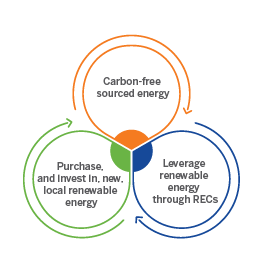Ways to (Realistically) Achieve Your Business’s Sustainability Goals
Chances are your company has made commitments to environmental sustainability, but do you truly understand what they are? Do you know how to address them—or even where to start?
Let’s start by defining environmental sustainability. It is the maintenance of the factors and practices that contribute to the quality of the environment on a long-term basis. Overall, it’s a plan in which the demands placed on the environment can be met without reducing its capacity to allow all people to live well, now and in the future. More than a buzzword, it’s a commitment to a safe, clean energy future.
For organizations, energy sustainability means being able to meet corporate efficiency goals through strategic solutions, including renewable energy options and energy efficiency initiatives. These reduce energy consumption—and thereby a company’s overall carbon footprint.
Businesses are leading the charge on strengthening sustainability and resource management with measures such as the implementation of solar and battery projects, innovative water reduction programs, fuel cells, electric vehicles and proactive monitoring of waste.
Sustainable energy has two key components:
- Renewable Energy: energy produced from sources that do not deplete or can be replenished within a human’s lifetime (compared with non-renewable sources like fossil fuels)
- Energy Efficiency: using a lower quantity of energy to provide the same amount of energy as a non-energy-efficient alternative, which can help lessen greenhouse gas emissions and therefore safeguard the environment
A sustainable energy strategy can and should take on a mix of energy sources. Below are three action steps (in no particular order) that could be a part of your strategy:

Action Step #1—Choose carbon-free energy sources
A meaningful step to take on the road to sustainability is choosing carbon-free energy, the sources of which do not emit any carbon dioxide when they generate energy. Carbon-free options include nuclear, solar, wind and hydroelectric energy.
Action Step #2—Leverage RECs to offset carbon footprint
Renewable energy certificates (RECs) are proof that energy has been generated from renewable sources, such as solar energy, wind power, hydropower, geothermal energy and/or biomass energy. Each REC represents the environmental benefits of 1MWh of renewable energy generation and may be sold and traded. The purchaseof RECs helps replace fossil fuel-based electricity generation in the region where the renewable electricity generator is located, and REC owners can legally claim to have purchased renewable energy.
Action Step #3—Invest in local renewable energy
Corporations, their employees, their customers and their supply chain partners have made sustainable energy procurement a priority. Current trends show that companies are looking not only to source energy from renewable products but also to be able to unequivocally show where that renewable energy comes from. Depending on your specific needs, through retail electric power supply contracts or Offsite Power Purchase Agreement (PPA) contracts, you can now invest and source energy from new renewable projects through Constellation’s CORe+ product.
Most importantly, when it comes to your company’s sustainability goals, keep in mind you don’t have to hit a home run right away—you can use an incremental approach. You could start, for instance, by switching to carbon-free products; that is a solid first step. Based on your company’s specific needs, your solution can be as simple or complex as necessary to help achieve your corporate efficiency commitments.
You could start, for instance, by switching to carbon-free products; that is a solid first step.
With sustainability efforts, there is no specific destination per se; it’s a work in progress with continuously evolving endpoints. When it comes to setting goals for energy sustainability activities, it is critical to find the right pace for your organization. It’s equally as important to have the right energy supplier to help you navigate what can sometimes be an overwhelming and seemingly complicated process—one that can help ensure your organization is on the right path and receiving the greatest benefit based on your overall company strategy.
*This blog post is a part of our “Supplier to Strategist: A Blog Series on Sustainability, Efficiency and Technology” where we will provide the framework for customers on how to develop and achieve their long-term sustainability strategy and goals, and understand the innovative management products and solutions that can make a direct impact on their bottom line.
Guest Author: Raj Bazaj Executive Director – Solution Sales
Raj Bazaj is the Executive Director for Solution Sales at Constellation. With over twenty years of sales experience, Raj manages a team at Constellation that works with a diverse group of customers assisting them in implementing solutions to help address the major shifts going on in the energy industry including sustainability, demand reduction, data analytics, and overall cost optimization. Raj has a B.S. in chemical engineering from the University of Arizona and an Executive MBA from the University of Connecticut.

